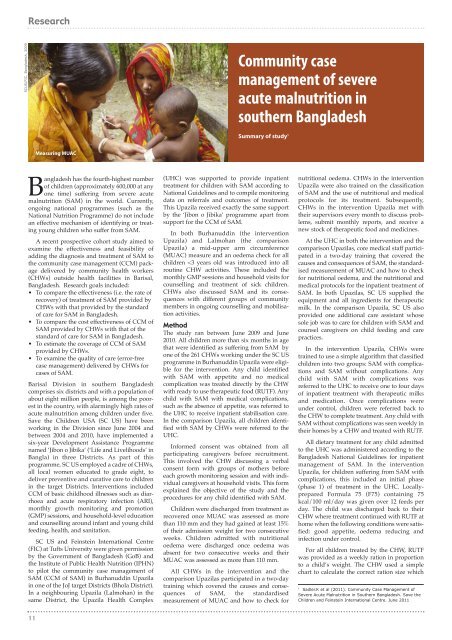Download a PDF of this issue - Field Exchange - Emergency ...
Download a PDF of this issue - Field Exchange - Emergency ...
Download a PDF of this issue - Field Exchange - Emergency ...
Create successful ePaper yourself
Turn your PDF publications into a flip-book with our unique Google optimized e-Paper software.
Research<br />
SCUS/FIC, Bangladesh, 2009<br />
Community case<br />
management <strong>of</strong> severe<br />
acute malnutrition in<br />
southern Bangladesh<br />
Summary <strong>of</strong> study 1<br />
Measuring MUAC<br />
Bangladesh has the fourth-highest number<br />
<strong>of</strong> children (approximately 600,000 at any<br />
one time) suffering from severe acute<br />
malnutrition (SAM) in the world. Currently,<br />
ongoing national programmes (such as the<br />
National Nutrition Programme) do not include<br />
an effective mechanism <strong>of</strong> identifying or treating<br />
young children who suffer from SAM.<br />
A recent prospective cohort study aimed to<br />
examine the effectiveness and feasibility <strong>of</strong><br />
adding the diagnosis and treatment <strong>of</strong> SAM to<br />
the community case management (CCM) package<br />
delivered by community health workers<br />
(CHWs) outside health facilities in Barisal,<br />
Bangladesh. Research goals included:<br />
• To compare the effectiveness (i.e. the rate <strong>of</strong><br />
recovery) <strong>of</strong> treatment <strong>of</strong> SAM provided by<br />
CHWs with that provided by the standard<br />
<strong>of</strong> care for SAM in Bangladesh.<br />
• To compare the cost effectiveness <strong>of</strong> CCM <strong>of</strong><br />
SAM provided by CHWs with that <strong>of</strong> the<br />
standard <strong>of</strong> care for SAM in Bangladesh.<br />
• To estimate the coverage <strong>of</strong> CCM <strong>of</strong> SAM<br />
provided by CHWs.<br />
• To examine the quality <strong>of</strong> care (error-free<br />
case management) delivered by CHWs for<br />
cases <strong>of</strong> SAM.<br />
Barisal Division in southern Bangladesh<br />
comprises six districts and with a population <strong>of</strong><br />
about eight million people, is among the poorest<br />
in the country, with alarmingly high rates <strong>of</strong><br />
acute malnutrition among children under five.<br />
Save the Children USA (SC US) have been<br />
working in the Division since June 2004 and<br />
between 2004 and 2010, have implemented a<br />
six-year Development Assistance Programme<br />
named ‘Jibon o Jibika’ (‘Life and Livelihoods’ in<br />
Bangla) in three Districts. As part <strong>of</strong> <strong>this</strong><br />
programme, SC US employed a cadre <strong>of</strong> CHWs,<br />
all local women educated to grade eight, to<br />
deliver preventive and curative care to children<br />
in the target Districts. Interventions included<br />
CCM <strong>of</strong> basic childhood illnesses such as diarrhoea<br />
and acute respiratory infection (ARI),<br />
monthly growth monitoring and promotion<br />
(GMP) sessions, and household-level education<br />
and counselling around infant and young child<br />
feeding, health, and sanitation.<br />
SC US and Feinstein International Centre<br />
(FIC) at Tufts University were given permission<br />
by the Government <strong>of</strong> Bangladesh (GoB) and<br />
the Institute <strong>of</strong> Public Health Nutrition (IPHN)<br />
to pilot the community case management <strong>of</strong><br />
SAM (CCM <strong>of</strong> SAM) in Burhanuddin Upazila<br />
in one <strong>of</strong> the JoJ target Districts (Bhola District).<br />
In a neighbouring Upazila (Lalmohan) in the<br />
same District, the Upazila Health Complex<br />
(UHC) was supported to provide inpatient<br />
treatment for children with SAM according to<br />
National Guidelines and to compile monitoring<br />
data on referrals and outcomes <strong>of</strong> treatment.<br />
This Upazila received exactly the same support<br />
by the ‘Jibon o Jibika’ programme apart from<br />
support for the CCM <strong>of</strong> SAM.<br />
In both Burhanuddin (the intervention<br />
Upazila) and Lalmohan (the comparison<br />
Upazila) a mid-upper arm circumference<br />
(MUAC) measure and an oedema check for all<br />
children
















